Celebrations
IN KIKINDA, WITH PUMPKINS AND CINDERELLAS, AND GAJDE ON TOP
About Pumpkins and Sages
The event is called ”The Pumpkin Days”, and we are talking centuries. The Banatians know that they have survived many difficult times thanks to pumpkin, just like they know how to make dozens of different dishes from it. They know how far you can see when you stand on the right squash, just like they know who you should not plant them with because it will backfire. And so, the entire philosophy of life and a type of humor have been woven around pumpkins, like a web, as well as entertainment and care, business deals and marriages are arranged, as well as sweet little conspiracies which make it easier to wait for the spring in the plains
By: Dragan Batinić
Photographs: Tamara Ristić
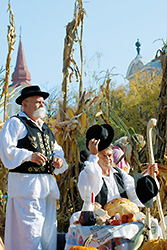 And then the fairy godmother tapped the pumpkin with her magic wand and turned it into a luxury carriage which took Cinderella into a better life. The citizens of Kikinda traditionally, every October, organize an event called ”The Pumpkin Days”. At this year’s festivals, the twenty eighth, there were all sorts of pumpkins, in abundance, and there were also fairy godmothers in the carnival procession. And then the fairy godmother tapped the pumpkin with her magic wand and turned it into a luxury carriage which took Cinderella into a better life. The citizens of Kikinda traditionally, every October, organize an event called ”The Pumpkin Days”. At this year’s festivals, the twenty eighth, there were all sorts of pumpkins, in abundance, and there were also fairy godmothers in the carnival procession.
– When we came to the idea to organize ”The Pumpkin Days”, we were already in a kind of a magic carriage – says Dragiša Ugarčina from the municipal tourist organization, one of the founders of this festival. – Kikinda was at the very top of the former big state, there was no unemployment, people worked and had good life. We wanted to make everything even merrier with a festival through which we would primarily promote culinary delights made of pumpkin. Other programs were included later. When we began to realize that our carriage was a bit rotten, that it has parts falling off and that its wheels were wobbling, in addition to touristic and cultural and entertainment programs, we included entrepreneurial programs into ”The Pumpkin Days”, connecting people involved in different lines of business. Many people and many ideas in one place. There are certainly those who have seized the opportunity, for business or for marriage. In Banat, tying the knot while standing on a pumpkin makes it even more effective.
MANY SQUASHES AND LITTLE THEORY
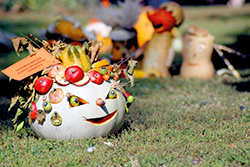 Within ”The Pumpkin Days”, two miniature fairs take place today: entrepreneurship and tourism. Businessmen and people working in tourist industry from neighboring Romania and Hungary, as well as from all former Yugoslav republics, presented their offers. ”All that is missing now is Marshall Tito!” says a guy standing near a pile of pumpkins. And he was not missing, he was there, around, on certain booths, T shirts, badges, key chains, together with Draža, the ”Stones”, ”Barça” and all others without whose presence there is no fair in Serbia. Within ”The Pumpkin Days”, two miniature fairs take place today: entrepreneurship and tourism. Businessmen and people working in tourist industry from neighboring Romania and Hungary, as well as from all former Yugoslav republics, presented their offers. ”All that is missing now is Marshall Tito!” says a guy standing near a pile of pumpkins. And he was not missing, he was there, around, on certain booths, T shirts, badges, key chains, together with Draža, the ”Stones”, ”Barça” and all others without whose presence there is no fair in Serbia.
The market part of this year’s ”The Pumpkin Days” was special. There have never been so many sellers making sweets according to traditional recipes. Almost on every other booth there were hard candies, halva, gingerbread hearts, but the buyers were few. It is not t hat they would not like to sweeten a bit this bitter life but in Kikinda, alas, there are more customers for national dishes than for this. This is well known to the newly elected president of the municipality Pavle Markov, who gave up his mandate of a republic deputy and easy life of a politician in the capital, and took up hard work to, in addition to circuses, as he says, provide for the citizens of Kikinda bread, and something that goes with it. hat they would not like to sweeten a bit this bitter life but in Kikinda, alas, there are more customers for national dishes than for this. This is well known to the newly elected president of the municipality Pavle Markov, who gave up his mandate of a republic deputy and easy life of a politician in the capital, and took up hard work to, in addition to circuses, as he says, provide for the citizens of Kikinda bread, and something that goes with it.
– This is an opportunity for us to, in a relaxed atmosphere, be more creative in communication with our guests who would invest here. Our city used to be a major industry center. We have unused potentials in agriculture, and we are c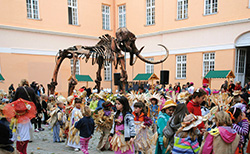 lose to the borders of the European Union (Romania is about a dozen kilometers away, Hungary a little farther...). If we go in a reverse order, from what we are used to, it will be fine. First we should find a mutual interest in business, and then it should give rise to socializing, fraternization and celebration, to the satisfaction of everybody. Fair is fine, but not only that – says Markov, tastes one of the delicacies made of pumpkin and rushes off among the booths to greet some other guests. lose to the borders of the European Union (Romania is about a dozen kilometers away, Hungary a little farther...). If we go in a reverse order, from what we are used to, it will be fine. First we should find a mutual interest in business, and then it should give rise to socializing, fraternization and celebration, to the satisfaction of everybody. Fair is fine, but not only that – says Markov, tastes one of the delicacies made of pumpkin and rushes off among the booths to greet some other guests.
We were let by the booth with pumpkin delicacies. We asked grandma Zorka, who prefers to be addressed with Auntie Zorka, whether pumpkin is still considered to be food for the poor.
– There was a lecture last night in Kikinda about pumpkin as healthy food – says Zorka. –It’s not by accident that they call it Banatian banana, with all the nutrition. But our people somehow prefer things that belong to someone else.
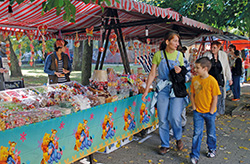 She talks and shows many dishes made of pumpkin, boiled, stewed, roasted, baked, rolled, stuffed. A special delicacy is krkljuš, pumpkin jam that was being cooked in a pot right there on the spot. She talks and shows many dishes made of pumpkin, boiled, stewed, roasted, baked, rolled, stuffed. A special delicacy is krkljuš, pumpkin jam that was being cooked in a pot right there on the spot.
Kosta, a village philosopher, on the other hand, is interested in pumpkins from a different perspective. Firstly, however, he has to explain the key difference between a village philosopher and politician-philosopher:
– Well, we philosophize, but we also work.
Is it clear? And now a theory:
– Long time ago, our ancestors used to live off of acacia trees, because there were no other trees here. And why did they come down? Well, for pumpkins. When they saw them so beautiful and colorful – he points at his booth with little decorative squashes – and especially after they discovered these were good as food, they could not resist. That is how today’s Lala (a person who lives in Banat) has come into being.
PUMPKINS ON A THIN STRING
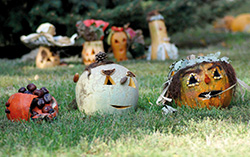 All conversations at ”The Pumpkin Days” had musical background. While Kosta, a village philosopher, is talking, the stage is occupied by tambura players from Kikinda and the famous singer Milan Prunić Duma, and at some distance from them a gajde player Branislav Zarić and ”Bećaruše”, and among them the famous Grandma Kata. She is not ashamed of the fact that she is a grandmother or the fact that she is singing bećarac (a humorous form of folk song), even the kinky ones. All conversations at ”The Pumpkin Days” had musical background. While Kosta, a village philosopher, is talking, the stage is occupied by tambura players from Kikinda and the famous singer Milan Prunić Duma, and at some distance from them a gajde player Branislav Zarić and ”Bećaruše”, and among them the famous Grandma Kata. She is not ashamed of the fact that she is a grandmother or the fact that she is singing bećarac (a humorous form of folk song), even the kinky ones.
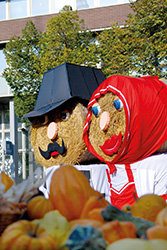 – You are not ashamed for doing that, why should I be ashamed for singing about it?! – You are not ashamed for doing that, why should I be ashamed for singing about it?!
Like pumpkins, there was music for everyone’s taste. In addition to tambura players, gajde players and traditional dance groups, there were three wind orchestras. One came from Belgrade, the police one, the other was from some place south, and the third one belonged to the local fire department. Of course, there were rock bands as well. ”Van Gog” from Belgrade, ”Antidepresiv” from Kikinda, and the audience gave special greeting to ”Frajle” from Novi Sad. People were also entertained by performers from TV s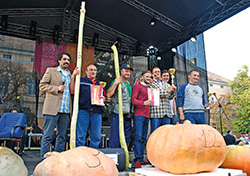 eries State Affairs, and for those who ”like to look smart” (as Kosta, the village philosopher, would say) there were several art exhibitions, theatrical performances and literary evenings. eries State Affairs, and for those who ”like to look smart” (as Kosta, the village philosopher, would say) there were several art exhibitions, theatrical performances and literary evenings.
And then came the moment many had been waiting for a year. Announcement of the winner. For the third time, Jožef Varga from Temerin grew the longest pumpkin, 252 centimeters long, breaking his own record. He did not reveal how he had done it. A young program developer from Srbobran, Miloš Dinjaški, produced the heaviest pumpkin, weighing 258.5 kilograms, but failed to break the record from three years ago when the winning pumpkin weighed 266 kilograms.
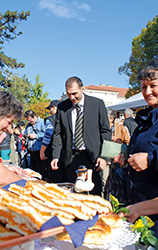 Thus, we do not know how this year’s winners had been growing their pumpkins, but it is known that one of the previous winners, in addition to watering and fertilizing them, also played music to his pumpkins, tamburica music, to propel their growth. The visitors were also able to here many other interesting things here. For example, the fact that this city is the biggest wintering grounds for eagle owls in the world, that an international sculpting symposium of terracotta sculptures had been taking place here for more than three decades, that a skeleton of a prehistoric mammoth is kept in the museum, and its faithful replica in the yard. For this occasion, a suvača – horse driven mill – was also opened. This one in Kikinda is one of two preserved in the world, the other one is in Hungary... Therefore, a little bit of entertainment, a little bit of art, some curiosities, a bit of history, and hopefully there will be a better future as well. Thus, we do not know how this year’s winners had been growing their pumpkins, but it is known that one of the previous winners, in addition to watering and fertilizing them, also played music to his pumpkins, tamburica music, to propel their growth. The visitors were also able to here many other interesting things here. For example, the fact that this city is the biggest wintering grounds for eagle owls in the world, that an international sculpting symposium of terracotta sculptures had been taking place here for more than three decades, that a skeleton of a prehistoric mammoth is kept in the museum, and its faithful replica in the yard. For this occasion, a suvača – horse driven mill – was also opened. This one in Kikinda is one of two preserved in the world, the other one is in Hungary... Therefore, a little bit of entertainment, a little bit of art, some curiosities, a bit of history, and hopefully there will be a better future as well.
***
We Can No Longer Go Upside-Down
Pavle Markov, the new president of the Municipality of Kikinda, was not joking when he said that things must turn around because they had been standing upside-down. First we must thing about how to make a living, and the rest will come from that. That is why he first received his guests, especially state officials, in his cabinet, where they had serious discussions about investments and development, employment and infrastructure, and only then they would go to a cocktail or fair, whatever they preferred. Among them were ministers, they promised to do everything in order to complete the reconstruction of Kikinda–Bašaid Road, which is the first section on the road to Belgrade, and then they said that the government had been planning serious funds for the construction of agro-industrial zones, for which Kikinda was among the first top submit a project... We will see. Everybody is hoping that Kosta, the village philosopher, will be finally proven wrong.
***
Angels under the Mask
Just like in the past years, the carnival of masked children attracted most attention of the audience. Ethnologists related this with pre-Christian beliefs, ecologists were advocating natural materials, little politicians were firing great slogans, and the children and audience simply enjoyed the play and creativity.
|
